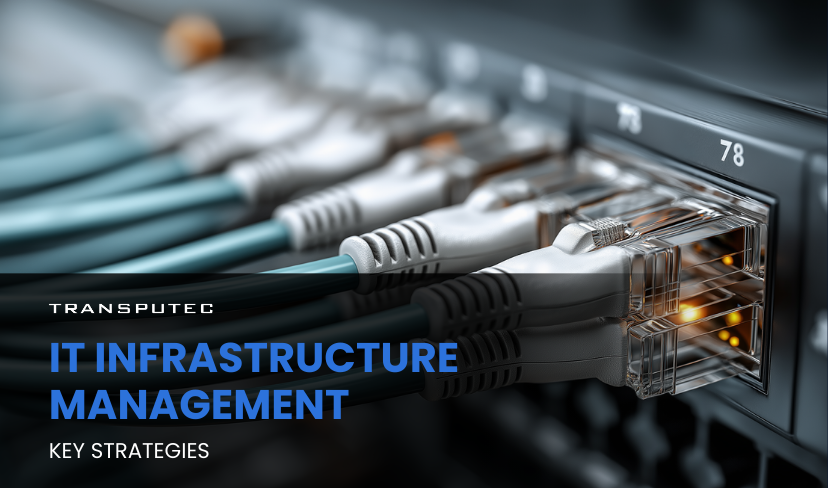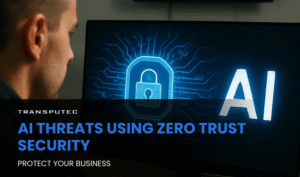Written by KRITIKA SINHA | MARKETING
The moment your business begins to grow, your IT infrastructure starts working overtime—and if it’s not managed properly, it breaks down. Systems crash during peak hours, software updates stall operations, employees lose time waiting for IT fixes, and cybersecurity risks grow unchecked. These challenges aren’t just frustrating; they cost businesses time, money, and trust.
This blog is designed to be your hands-on guide to IT Infrastructure Management efficiently. Whether you’re a decision-maker at a mid-sized enterprise or an IT manager juggling multiple platforms, we’ll dive into proven strategies, share real-world insights, and show how partnering with experts like Transputec simplifies infrastructure management. You’ll learn about key challenges, best practices, automation, monitoring tools, cloud integration, and security protocols. Plus, discover how businesses like yours have transformed their IT operations with expert support.
Why You Must Effectively Manage IT Infrastructure?
Failing to manage IT infrastructure properly results in more than just technical glitches—it leads to lost revenue, security breaches, and weakened customer trust. IT is not just a support function anymore; it’s the engine that drives your operations, customer experience, and innovation efforts.
Key statistics to consider:
- According to Gartner, 70% of digital transformation failures stem from poor infrastructure and operations management.
- IDC reports that the average cost of unplanned downtime is $5,600 per minute.
- Cybersecurity Ventures highlights that 60% of small companies go out of business within six months of a cyberattack, often due to infrastructure weaknesses.
When you manage IT infrastructure effectively, you’re improving uptime, increasing employee productivity, and reducing risk.
Core Components of IT Infrastructure
To properly manage IT infrastructure, you first need to understand its essential components. Each area plays a vital role in overall system performance, and neglecting one can compromise the whole.
1. Hardware
This includes physical assets like servers, workstations, and data centres. Maintaining hardware involves regular updates, monitoring system health, and replacing ageing equipment to avoid failures.
2. Software
Operating systems, business applications, and internal tools must be patched and upgraded routinely to ensure compatibility and security.
3. Network
Switches, routers, firewalls, and wireless infrastructure form your connectivity backbone. A well-configured network enables fast, secure communication and prevents bottlenecks.
4. Cloud Infrastructure
Platforms such as AWS, Microsoft Azure, and Google Cloud provide flexible, scalable resources. Managing this involves resource allocation, cost optimisation, and governance.
5. Security Infrastructure
Firewalls, antivirus programs, multi-factor authentication, and encryption tools protect your systems and data. These need continuous monitoring and updating.
6. IT Services and Support
This includes help desks, service desks, patch management systems, and remote monitoring tools that keep daily operations running smoothly.
By taking a comprehensive view of these elements, you’ll manage IT infrastructure with clarity and purpose.
Ready to Take Control of Your IT Infrastructure?
Connect with us today for our free consultation!
Key Strategies of IT Infrastructure Management
1. Proactive Monitoring and Alerting
Use monitoring tools to continuously check your systems for issues such as slow performance, hardware failures, or suspicious network activity. For instance, Transputec uses real-time monitoring systems that send alerts as soon as issues arise, allowing teams to take immediate action. This significantly reduces downtime and improves user experience.
2. Standardisation and Documentation
Implementing consistent processes and documenting system configurations helps reduce errors and ensures that all IT staff follow the same procedures. This is critical when troubleshooting issues or onboarding new team members.
3. Automation and Orchestration
Automate repetitive tasks such as software updates, user provisioning, and security scans. Tools like Ansible or Transputec’s automation frameworks can help streamline operations and reduce human error.
4. Cloud Integration and Hybrid Models
A hybrid model allows you to keep critical systems on-premises while taking advantage of cloud scalability. Transputec helps businesses assess which workloads are cloud-ready and which are better kept in-house, balancing cost and performance.
5. Cybersecurity Management
Effective infrastructure management includes strong cybersecurity. Transputec integrates threat detection, vulnerability assessments, and endpoint protection into your infrastructure plan. A layered security model ensures continuous protection against evolving threats.
6. Regular Audits and Compliance Checks
Routine audits help ensure your IT systems meet industry regulations such as ISO 27001, GDPR, or PCI-DSS. Transputec supports clients by conducting these audits, identifying weaknesses, and implementing improvements.
7. Business Continuity and Disaster Recovery
Create backup plans that allow your business to continue operating even during system outages or cyber incidents. Transputec’s disaster recovery solutions include data backups, secondary systems, and response plans tested regularly.
8. Scalable Infrastructure Design
Design your infrastructure with growth in mind. Choose modular solutions that can be expanded easily. Transputec works with clients to forecast growth and develop infrastructure that supports business expansion without requiring a full redesign.
Common Pitfalls in IT Infrastructure Management
Even with skilled IT teams and decent budgets, businesses often encounter recurring challenges when managing IT infrastructure. These pitfalls may seem minor at first, but can snowball into serious problems if left unchecked. Understanding them is the first step toward building a more resilient and high-performing IT environment.
1. Relying on Outdated or Legacy Systems
Legacy systems may still “work,” but they lack the flexibility, scalability, and security of modern technologies. Over time, outdated systems become more expensive to maintain, incompatible with new software, and more vulnerable to cyber threats.
How Transputec helps:
We evaluate your legacy systems, plan seamless upgrades or migrations (e.g., to the cloud or hybrid environments), and ensure continuity with minimal disruption to business operations.
2. Lack of Centralised and Up-to-Date Documentation
When system configurations, network diagrams, and security protocols are not properly documented, IT teams struggle with troubleshooting, system changes, or onboarding new team members. This creates bottlenecks and knowledge silos, especially if key personnel leave.
How Transputec helps:
We create and maintain centralised documentation for all critical systems and processes, making it easier for your internal or external teams to access accurate information quickly.
3. Treating Cybersecurity as a Separate Concern
Some organisations still view cybersecurity as something separate from infrastructure. In reality, they are inseparable. Every piece of your IT infrastructure, from email servers to employee laptops, is a potential entry point for attacks.
How Transputec helps:
We embed cybersecurity into your infrastructure from day one, providing proactive threat monitoring, vulnerability scanning, and policy enforcement as part of a unified management approach.
4. Inadequate Monitoring and Reactive Problem Solving
If you’re only reacting to problems when something breaks, you’re already too late. Without proactive monitoring, performance bottlenecks, security threats, and system misconfigurations go unnoticed until they impact end users.
How Transputec helps:
We implement real-time infrastructure monitoring and alerting tools that detect issues before they escalate. Our clients benefit from 24/7 support and immediate incident response.
5. No Clear Disaster Recovery or Business Continuity Plan
Many businesses assume their systems will always be available, without planning for disasters such as data centre failures, ransomware attacks, or power outages. When disruption occurs, they have no tested plan to recover quickly.
How Transputec helps:
We design and test comprehensive business continuity and disaster recovery (BCDR) plans that include regular data backups, off-site storage, and predefined recovery time objectives (RTOs) and recovery point objectives (RPOs).
How Transputec Helps You Manage IT Infrastructure
Transputec doesn’t just offer services, we provide long-term partnerships and expert guidance tailored to your business needs. With over 35 years of experience in managed IT services, we understand the complexity of infrastructure management and offer practical, scalable solutions.
Our services include:
- Infrastructure assessment and planning
- 24/7 system monitoring and incident response
- Cloud migration and hybrid IT management
- Cybersecurity management
- Automation and process optimisation
- Disaster recovery and backup solutions
Conclusion: Securing Your Competitive Edge
Managing IT infrastructure is a strategic necessity. It supports business continuity, enables growth, and protects your organisation from avoidable risks. From cloud optimisation to automated monitoring and cybersecurity, every component plays a critical role in performance and resilience.
By implementing the strategies in this blog and working with a trusted partner like Transputec, you can move from reactive IT management to a proactive, business-enabling approach.
If you’re ready to improve your system performance, reduce risk, and scale efficiently, we’re here to help.
Contact us today to connect with a Transputec expert and get started on a smarter way to manage IT infrastructure.

Ready to experience the Transputec difference?
Contact us today to schedule a consultation with our experts.
FAQs
1. What does it mean to manage IT infrastructure?
Managing IT infrastructure means ensuring that all technology assets, hardware, software, network, cloud, and security are monitored, maintained, and optimised to support business operations efficiently and securely.
2. How does Transputec help manage IT infrastructure?
Transputec offers infrastructure consulting, 24/7 monitoring, cloud integration, cybersecurity, and disaster recovery services. Our solutions are tailored to each client’s specific needs, with a focus on automation and long-term performance.
3. Is outsourcing IT infrastructure cost-effective?
Yes. Outsourcing reduces overhead, improves uptime, and gives businesses access to expert tools and resources without the cost of an in-house team. Transputec’s managed services deliver enterprise-grade results without the enterprise price.
4. How often should IT systems be reviewed?
We recommend reviewing the infrastructure quarterly. Transputec provides regular audits, reports, and strategy updates to ensure your systems evolve with your business needs.
5. What industries does Transputec support?
Transputec works with clients across finance, healthcare, legal, retail, and government. Our team has deep industry experience, allowing us to tailor infrastructure strategies to meet sector-specific compliance and operational requirements.







